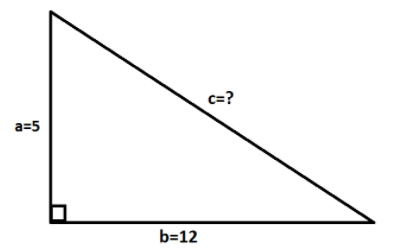
How do you find the missing side of the right triangle with legs:
Answer
460.5k+ views
Hint: Here, we are given the dimensions of two legs of the right angle triangle. Therefore, it is obvious that the missing side is the hypotenuse which is the longest sie of the triangle opposite to the right angle. For finding our answer, we will use the Pythagoras law.
Complete step-by-step solution:
We are given the legs of the right angle triangle as
Let the missing side which is hypotenuse is

We know that the Pythagoras theorem states that in a right-angled triangle, the square of the hypotenuse side is equal to the sum of squares of the other two sides.
Therefore, if we apply the Pythagoras theorem in our case, we get
We are given that
Thus, the value of the missing side in the right angle triangle is
Note: We have used the Pythagoras theorem to solve this question. There is another theorem which is called the inverse of Pythagoras theorem. The inverse of the Pythagorean Theorem is: If the square of the length of the longest side of a triangle is equal to the sum of the squares of the other two sides, then the triangle is a right triangle. Also, The Pythagorean Theorem is useful for two-dimensional navigation. We can use it and two lengths to find the shortest distance, the distances north and west will be the two legs of the triangle, and the shortest line connecting them will be the diagonal.
Complete step-by-step solution:
We are given the legs of the right angle triangle as
Let the missing side which is hypotenuse is

We know that the Pythagoras theorem states that in a right-angled triangle, the square of the hypotenuse side is equal to the sum of squares of the other two sides.
Therefore, if we apply the Pythagoras theorem in our case, we get
We are given that
Thus, the value of the missing side in the right angle triangle is
Note: We have used the Pythagoras theorem to solve this question. There is another theorem which is called the inverse of Pythagoras theorem. The inverse of the Pythagorean Theorem is: If the square of the length of the longest side of a triangle is equal to the sum of the squares of the other two sides, then the triangle is a right triangle. Also, The Pythagorean Theorem is useful for two-dimensional navigation. We can use it and two lengths to find the shortest distance, the distances north and west will be the two legs of the triangle, and the shortest line connecting them will be the diagonal.
Recently Updated Pages
Master Class 9 General Knowledge: Engaging Questions & Answers for Success

Master Class 9 English: Engaging Questions & Answers for Success

Master Class 9 Science: Engaging Questions & Answers for Success

Master Class 9 Social Science: Engaging Questions & Answers for Success

Master Class 9 Maths: Engaging Questions & Answers for Success

Class 9 Question and Answer - Your Ultimate Solutions Guide

Trending doubts
State and prove Bernoullis theorem class 11 physics CBSE

What are Quantum numbers Explain the quantum number class 11 chemistry CBSE

Who built the Grand Trunk Road AChandragupta Maurya class 11 social science CBSE

1 ton equals to A 100 kg B 1000 kg C 10 kg D 10000 class 11 physics CBSE

State the laws of reflection of light

One Metric ton is equal to kg A 10000 B 1000 C 100 class 11 physics CBSE




